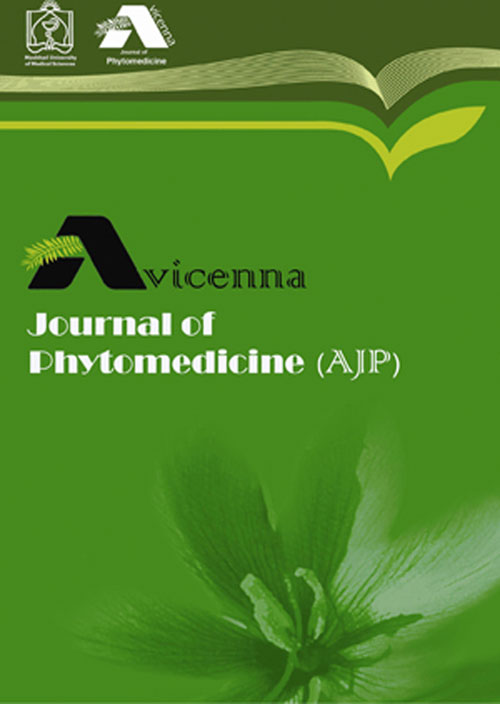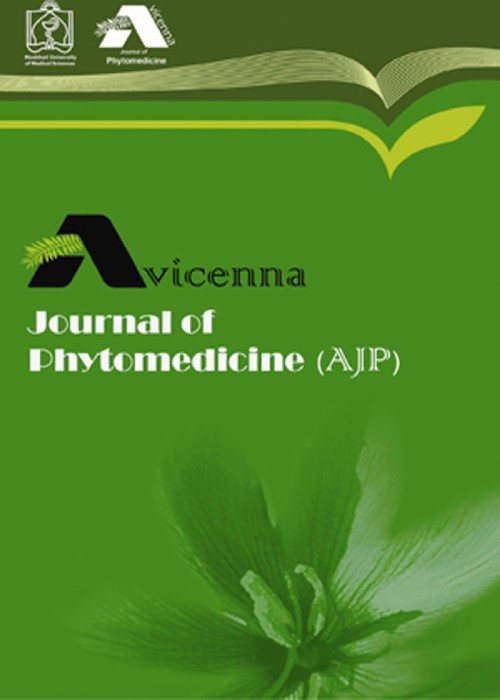فهرست مطالب

Avicenna Journal of Phytomedicine
Volume:12 Issue: 6, Nov-Dec 2022
- تاریخ انتشار: 1401/08/07
- تعداد عناوین: 8
-
-
Pages 559-565Objective
Recently, the European Food Safety Authority (EFSA) has recommended to limit the use of total monacolins in red yeast rice (RYR) products to a dose <3 mg/day. However, data concerning the lipid lowering efficacy of the reduced dosage remain limited. A monacolin dose reduced due to safety issues may be expected to be less effective as a lipid lowering strategy and, for this reason, nutraceutical combinations with other active compounds may offer a viable solution as they can act synergistically through different mechanisms.
Materials and MethodsThis 8-week open-label study was designed to investigate the safety and efficacy of a novel ESFA-compliant lipid lowering nutraceutical combination (Colestarmony Plus®; containing total monacolins from RYR at a dose of 2.9 mg/day, a highly bioavailable berberine formulation, and pomegranate extract) in subjects (n=40) with mild-to-moderate hypercholesterolemia and no history of cardiovascular disease.
ResultsAfter 8 weeks of supplementation, Colestarmony Plus® significantly reduced total cholesterol (−10.4%, p<0.05), low-density lipoprotein cholesterol (−14.8%, p<0.05), oxidized low-density lipoprotein cholesterol (−12.0%, p<0.05), and high-sensitivity C-reactive protein (−14.0%, p<0.05) compared with baseline values. A subgroup of 22 patients underwent measurements of flow-mediated dilation, with values increasing by 18.0% at 8 weeks with respect to baseline (p<0.05). The supplement was generally well-tolerated.
ConclusionOur short-term results indicate that the tested ESFA-compliant nutraceutical is effective in a primary prevention setting, even by providing only <3 mg/day of monacolins.
Keywords: Monacolins, Berberine, Pomegranate, Nutraceutical, Hypercholesterolemia, Primary prevention -
Pages 566-575Objective
Traditional herbal plants have been in use since ancient times to treat ophthalmic conditions; so, the aim of this study is to evaluate some potent Indian traditional medicinal plants used in ophthalmic diseases in order to summarize their potential effect in ophthalmology along with their mechanism of action.
Materials and MethodsDatabases PubMed, Google Scholar, and Embase were extensively explored. Additionally, relevant textbooks and literatures were consulted to summarize most of the considerable scientific literature for the review. Search term included ophthalmology, glaucoma, cataract, trachoma, conjunctivitis, traditional medicines, Unani drugs, and ayurvedic drugs were used. Around 80 review articles were consulted from the year 1982 to 2021.
ResultsThe traditional medicinal plants are easily available, cost-effective and have no associated side effects in comparison to current conventional treatments. Moreover, these drugs in oppose to modern medicine, have an inherent potential to accelerate the body’s own immunity to fight against any infection. A large volume of scientific studies has reported the beneficial effects of traditional drugs in ophthalmology.
ConclusionThis review, therefore, describes the potential benefits and uses of some traditional medicinal plants used in ophthalmic diseases.
Keywords: Ophthalmology, Atropa belladonna, Crocus sativus, Coptis teeta, Foeniculum vulgare, Gingko biloba -
Pages 576-588Objective
This study was designed to determine the association curcumin has on pro-inflammatory biomarkers in patients with chronic kidney disease (CKD (and in those receiving hemodialysis (HD).
Materials and MethodsThis meta-analysis was undertaken following PRISMA guidelines. An extensive systematic review was undertaken until 10/11/2021 using PubMed, Web of Science (ISI), and Scopus databases. The standardized mean difference (SMD) and 95% confidence intervals (CI) were used to estimate the overall effect size of curcumin on serum high-sensitivity C-reactive protein (hs-CRP), and pro-inflammatory cytokines including interleukin 6 (IL-6), and tumor necrosis factor α (TNF-α) in patients with CKD and those receiving HD.
ResultsOverall, ten randomized controlled trials (RCTs) comprising 523 patients were incorporated into the systematic review and meta-analysis. The results showed that when compared with control groups, there was no significant effect observed linking curcumin and IL-6 (SMD = 0.24%, 95% CI = -0.14 to 0.62, p = 0.221), TNF-α (SMD = 0.11%, 95% CI = -0.19 to 0.40, p = 0.480) or hs-CRP (SMD = -0.17%, 95% CI = -0.36 to 0.03, p = 0.093). The analysis determined no publication bias related to the influence of curcumin on IL-6, TNF-α or acute phase reactant, hs-CRP. The Egger’s and Begg’s test results were not statistically significant (p˃0.20).
ConclusionIn patients with CKD and those receiving HD, the use of curcumin supplementation has no statistically significant effect on the anti-inflammatory biomarkers reviewed in this study.
Keywords: chronic kidney disease, hemodialysis, Curcumin, Inflammation -
Pages 589-601Objective
The aim of this study was to evaluate the effect of crocin on the prevention of atrial fibrillation after coronary artery bypass grafting (CABG) and heart valve replacement.
Materials and Methods100 patients who were scheduled for CABG or heart valve replacement surgeries were randomly assigned into two groups of treatment and placebo. In the treatment group, patients received crocin tablets from three days prior to surgery and on the first three postoperative days (for a total of six days). During the first three days after surgery, postoperative atrial fibrillation (POAF) was assessed by electrocardiogram monitoring. Prooxidant–antioxidant balance (PAB) and c-reactive protein (CRP) levels were also assessed.
ResultsPOAF developed in 7 patients in the treatment group versus 18 patients in the control (p=0.02). PAB levels were significantly lower in the crocin group (p<0.001), while differences in CRP levels were insignificant (p=0.39).
ConclusionIt seems that prophylactic use of crocin is effective in reducing the incidence of POAF in patients undergoing heart surgeries.
Keywords: Atrial fibrillation, Coronary artery bypass graft, Heart valve replacement, Crocin -
Pages 602-613ObjectivePeripheral nerve injury is a clinical problem that may cause sensory and motor inabilities. Sesamol is an antioxidant that can help in repairing damaged central nervous system (CNS) and other organs. The present study aimed to investigate whether the antioxidant effects of sesamol could improve the function, structure, and myelination in rats’ damaged peripheral nervous system (PNS).Materials and MethodsIn this study, 28 adult male Wistar rats were randomly divided into four groups. In the sham group, the sciatic nerve was exposed and restored to its place without inducing crush injury. The control received DMSO (solvent) and the two experimental groups received 50 or 100 mg/kg sesamol intraperitoneally for 28 days after sciatic nerve crush injury, respectively. Next, sciatic function index (SFI), superoxide dismutase (SOD) activity, malondialdehyde (MDA) level, expression of nerve growth factor (NGF) and myelin protein zero (MPZ) proteins in the sciatic nerve, and histological indices of the sciatic nerve and gastrocnemius muscle were evaluated.ResultsThe results showed that sesamol reduced oxidative stress parameters, increased expression of NGF and MPZ proteins, and improved function and regeneration of the damaged sciatic nerve. Furthermore, a significant regeneration was observed in the gastrocnemius muscle after treatment with sesamol. Although administration of both doses of sesamol was useful, the 100 mg/kg dose was more effective than the 50 mg/kg one.ConclusionThe results suggest that sesamol may be effective in improving damaged peripheral nerves in rats by reducing oxidative stress and increasing the expression of NGF and MPZ proteins.Keywords: Nerve growth factor, MPZ protein, Oxidative stress, Peripheral nerve injuries, Regeneration, Sesamol
-
Pages 614-626Objective
Neuroprotective and antioxidant effects of Ocimum basilicum (O. basilicum) against pentylenetetrazole (PTZ)-induced seizures were investigated.
Materials and MethodsMice were divided as follows: (Group 1) Control, (Group 2) PTZ, (Groups 3-5) 50,100 and 200 mg/kg hydro-ethanolic (HE) extract, and (Groups 6-8) 200 mg/kg ethyl-acetate (EAF), N-hexane (NHF) and water (WF) fractions. Minimal clonic seizures (MCS) and generalized tonic-clonic seizures (GTCS) latencies were measured. Biochemical and histological studies were done.
ResultsMCS and GTCS latency in HE groups were longer than the PTZ group (p<0.05 to p<0.001). EAF and NHF prolonged the onset of MCS and GTCS (p<0.001). PTZ increased malondialdehyde (MDA) and dark neuron (DN) production while decreased thiol, catalase (CAT) and superoxide dismutase (SOD) (p<0.05 to p<0.001). Pre-treatment by HE and all fractions of the plant attenuated MDA and DN while increased thiol, CAT and SOD (p<0.01 to p<0.001).
ConclusionEAF and NHF had anticonvulsant properties. The extract and fractions protected the brain from PTZ-induced oxidative damages and showed neuroprotective effects.
Keywords: Neuroprotective, Ocimum basilicum, Oxidative stress, Pentylenetetrazole, Seizures -
Pages 627-637ObjectiveThe aim of this study was to evaluate the effect of four weeks of high intensity interval training (HIIT) with beetroot juice supplementation (BJ) on serotonin and dopamine receptors in hippocampal tissue, as well as anxiety and depression in middle-aged diabetic rats.Materials and MethodsIn this experimental study, 28 diabetic female rats (55 mg/kg, induced by streptozotocin) aged 12-14 months, weighing 280-320 g, were divided into (1) diabetic control (DC), (2) BJ, (3) HIIT, and (4) HIIT+BJ groups. Also, 7 healthy rats were included in the healthy control (HC) group to evaluate the effect of diabetes induction on the research variables. HIIT was performed for four weeks, 4 sessions per week (70-95% of maximum speed at high intensities; 50-60% of maximum speed at low intensities). Also, BJ was fed daily to rats at a dose of 10 ml/kg.ResultsHippocampal expression of dopamine receptor-1 (Dop.R), 5-hydroxytryptamine receptor (5-HT. R), open arm entry percentage (OAE%) and movement rate in the HIIT, BJ and HIIT+BJ groups were significantly higher than the DC group. In the HIIT+BJ group, open arm time percentage (OAT%) was higher than the DC group. Levels of Dop.R gene expression were more affected by HIIT, and levels of 5-HT. R were more affected by BJ supplementation; also, HIIT+BJ had a synergistic effect on reducing anxiety and depression.ConclusionAlthough HIIT was more effective than BJ and HIIT+BJ on Dop.R and BJ supplementation on 5-HT.R and improved anxiety and depression, both of HIIT and BJ were complementary in improving dopamine and serotonin receptor-dependent anxiety and depression and enhanced each other's effects.Keywords: HIIT, Beta vulgaris, Serotonin receptor, Dopamine receptor, Aging, Diabetes
-
Pages 638-648ObjectiveRhabdomyolysis is a life-threatening disease caused by releasing myoglobin from injured myocytes, which results in acute kidney injury. In this study, the effect of aqueous-alcoholic extract of Nigella sativa (NS) and thymoquinone (TQ) on rhabdomyolysis-induced kidney damage in rats was investigated.Materials and MethodsThere were five groups of rats (n=8): Control, rhabdomyolysis, rhabdomyolysis treated with NS aqueous-alcoholic extract (200 and 400 mg/kg) and TQ (15 mg/kg). Treatments were given for 7 days (two days before and four days after glycerol injection). Glycerol was injected intramuscularly on the third day of the experiment for induction of rhabdomyolysis. Renal function parameters on the first, fourth, and seventh days of the experiment and renal oxidative stress and histological changes at the end of this study were assessed.ResultsGlycerol injection caused a significant increase in serum level of urea, creatinine, creatine phosphokinase, urine output and tissue MDA compared to the control animals (p<0.05-0.001). Administration of NS extract and TQ significantly decreased serum urea and creatinine on days 4 and 7, creatine phosphokinase on day 4, and urine output on day 7 compared to the rhabdomyolysis group (p<0.05-0.001). Compared to the rhabdomyolysis group, treatment with NS extract and TQ improved kidney histological abnormalities (p<0.01-0.001). The catalase enzyme activity in the group treated with NS 400 mg/kg and thiol content in the NS 400 mg/kg and TQ groups were significantly higher than those of the rhabdomyolysis group (p<0.05-0.01).ConclusionNS extract and to some extent TQ protect the kidney from rhabdomyolysis-induced injury.Keywords: Nigella Sativa, Thymoquinone, rhabdomyolysis


